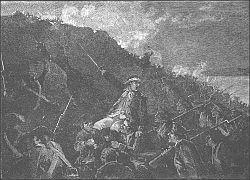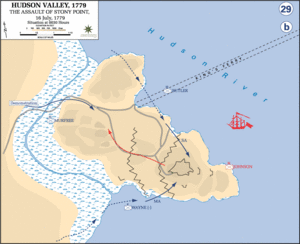Battle of Stony Point facts for kids
Quick facts for kids Battle of Stony Point |
|||||||
|---|---|---|---|---|---|---|---|
| Part of the American Revolutionary War | |||||||
 Capture of Stony Point by Wayne |
|||||||
|
|||||||
| Belligerents | |||||||
| Commanders and leaders | |||||||
| Anthony Wayne (WIA) | Henry Johnson (POW) | ||||||
| Strength | |||||||
| 1,500 | 750 | ||||||
| Casualties and losses | |||||||
| 15 killed 83 wounded |
20 killed 74 wounded prisoners 472 unwounded prisoners 58 missing |
||||||
The Battle of Stony Point happened on July 16, 1779, during the American Revolutionary War. It was a bold and quick attack by American soldiers. These highly trained troops were part of George Washington's Continental Army.
They were led by Brigadier General Anthony Wayne, also known as "Mad Anthony" Wayne. His forces surprised and defeated British troops at their outpost in Stony Point, New York. This place is about 30 miles (48 km) north of New York City.
The British lost many soldiers in this battle. For the Continental Army, it was a very important victory. It boosted their spirits and confidence. Even though the fort was left soon after, this key crossing point was used later in the war. American units crossed the Hudson River here on their way to winning the war.
Contents
Why Was Stony Point Important?
After the Battle of Saratoga in 1777, France joined the war to help the Americans. This made the British change their plans. In the northern states, they mostly focused on raids. They also tried to make Washington's army fight a big battle. But Washington kept his army in strong positions near New York City. He refused to be drawn into a major fight.
In 1779, the British commander, Sir Henry Clinton, wanted to force Washington to move his army. Clinton believed that capturing Stony Point would threaten Washington's supply lines. This would make Washington leave his strong positions near the Hudson River.
British Take Control
In May 1779, General Clinton led about 8,000 British, Loyalist, and Hessian soldiers up the Hudson River. They saw that Stony Point was a very important spot. It controlled that part of the Hudson River and the entrance to the Hudson Highlands. It also controlled the nearby Kings Ferry crossing.
The British decided to attack it. They landed without a fight. Stony Point was defended by only about 40 American Patriots. These few soldiers set fire to their unfinished fort and escaped. The British then brought cannons up the steep slopes of Stony Point. From there, they shelled nearby Fort Lafayette. This action closed King's Ferry, a major river crossing. It was about 10 miles (16 km) south of West Point.
The British left soldiers at Stony Point under the command of Lt. Col. Henry Johnson. They had cannons and a Royal Navy gunboat to protect the area.
Washington watched the British building their defenses from a nearby mountain. He also gathered information from local people. He learned about the British soldiers, their passwords, and where their guards were placed. This helped him plan an attack. He chose Brigadier General Anthony Wayne to lead it.
The British defenses at Stony Point were not a strong stone fort. They used earth mounds and wooden barriers called abatis. These were felled trees with sharpened points. The defenses were on a rocky hill. It could only be approached from the west. A wet ditch and swampy areas protected its sides.
How the Americans Planned Their Attack
To storm the fort, a special group of soldiers was formed. It was called the Corps of Light Infantry. General Wayne was put in charge. This group was made of elite, highly skilled soldiers. They were chosen from different regiments in Washington's army.
The plan was a night attack on the fort. About 1,350 men would take part. This number was usually not enough to capture a strong fort. But Washington's plan used the element of surprise. It also used a weakness in the British defenses.
The wooden barriers along the southern shore did not go into the deep water. This meant attackers could go around them along a narrow beach at low tide. The main attack would come from this side. Washington also suggested smaller attacks from the north and across the main road.
Washington gave Wayne his orders. He also gave Wayne permission to change the plan if needed. This showed how much Washington trusted Wayne's skills. The attack would be very hard. It would happen in the middle of the night. Soldiers would have to climb the steep, rocky sides of Stony Point.
To keep the attack a surprise, Washington ordered the men to carry unloaded muskets. They would attack using only bayonets. This tactic had been used by the British before. It had been very effective against Wayne himself at the Battle of Paoli two years earlier.
Only two companies of North Carolina soldiers had loaded weapons. They were told to cross the main road. They would make a loud attack in the middle of the British defenses. This would be a distraction. The British would expect the main attack to come from there.
Wayne chose about 300 men to attack along the northern shore. Wayne himself would lead the main attack column in the south. This column had about 1,000 men. Both groups had an advance force of 100 to 150 men. These men carried axes to clear obstacles. Twenty men from each advance force were called the "forlorn hope." They were the first to enter the fort. Wayne promised rewards to the first men who entered and to anyone who showed great bravery.
The Battle Begins
On July 15, the American soldiers began their march at noon. They took a long, winding path to avoid being seen by the British. Any civilians they met were held so they couldn't warn the enemy. By 10 p.m., the soldiers had arrived near the fort and were ready.
The men were given a drink of rum and their orders. They also pinned pieces of white paper to their hats. This would help them tell friends from enemies in the dark. The attack columns moved out at 11:30 p.m., ready to start the assault at midnight. The "forlorn hope" soldiers led the way, armed with axes and picks to break through defenses.
Bad weather helped the Americans that night. Clouds hid the moonlight. Strong winds forced British ships in the bay to move away from Stony Point. At midnight, the attack began. The American columns crossed the swampy areas around the point. The southern column found its path covered in two to four feet of water. It took them 30 minutes to wade through. During this time, British guards spotted them and fired.
Even under fire, Wayne's column got inside the first British defenses. Wayne himself was hit in the head by a musket ball. He fell, and Colonel Febiger took command of his column. Meanwhile, the other American column also broke through the defenses. They had the only American deaths during this part of the attack. Both columns entered the British lines almost at the same time. They quickly took the top of the hill.
The British cannons on the hill could not stop the fast-moving American soldiers. The cannons could not be aimed low enough to hit the men climbing up the hill.
The first man to enter the British fort was Lt. Col. Francois de Fleury, a French engineer. He was followed by other brave soldiers. As the Americans entered, they shouted, "The fort's our own!" This was their secret signal to tell friends from enemies. The battle lasted only 25 minutes. It was over by 1 a.m.
The Americans lost 15 killed and 83 wounded. They captured 546 British soldiers, including 74 who were wounded. British reports said 20 of their soldiers were killed. Many others were missing and might have drowned.
Before dawn, Wayne sent a message to Washington. He said, "The fort and garrison, with Colonel Johnston, are ours. Our officers and men behaved like men who are determined to be free." The next day, Washington visited the battlefield. He congratulated the troops for their bravery. Congress gave Wayne a medal for his actions.
What Happened After the Battle?
Capturing Stony Point was a huge boost for the Continental Army's morale. It also helped Washington keep control of nearby West Point. Washington visited the battle site on July 17. He praised the soldiers after seeing the difficult land they had crossed.
Washington had also planned to attack Verplanck's Point after Stony Point. American forces tried to attack Verplanck's, but they didn't have enough cannons or equipment. So, they could only block the fort. When more British troops arrived, the Americans decided to pull back.
Washington never planned to hold Stony Point for long. The Americans left it on July 18. They took all the captured cannons and supplies with them. The British briefly took the site back. But they abandoned it in October 1779. This was because General Clinton was preparing a major attack on the southern states.
Some of the captured British officers were exchanged quickly. But over 400 other prisoners were sent to a prison camp. The British commander of Stony Point, Colonel Johnson, was later put on trial in New York City. He was accused of not defending the fort well enough.
Stony Point Today
Stony Point is about 30 miles (48 km) north of New York City. Its location was very important for controlling the lower Hudson River. It also controlled Kings Ferry, a major crossing point. This ferry was key for trade and supplies between New England and the other colonies.
Twelve miles (19 km) north of Stony Point was West Point. This made the fort even more important for the security of that area. West Point was a vital fortress for General George Washington's army. It helped them control the upper parts of the Hudson River.
Stony Point is a rocky piece of land that sticks out into the Hudson River. It has steep, rocky slopes that rise up to 150 feet (46 m). These natural defenses made attacking it very difficult. It was even nicknamed "Little Gibraltar."
At the time of the battle, Stony Point was almost an island. Water surrounded it on all sides except the west. There, a swampy area nearly cut it off from dry land. Today, the swamp is mostly dry. But the area is still much the same. There is now a lighthouse and a museum on the hill.
Preserving the Battlefield
The Stony Point State Historic Site protects the battlefield. It has information, tours, and demonstrations, especially in the summer. A museum at the site shows items from the battle. These include a howitzer and two mortars. The site was named a National Historic Landmark in 1961.
Many of the original defenses built by the British still exist today. Markers and memorials remember important spots on the hill. The slopes leading up to the top were once cleared of all trees for defense. Now, they are covered with plants again.
Stony Point in Media
A made-up version of the battle appears in season three of the AMC television series Turn: Washington's Spies. However, the show incorrectly shows the battle happening in winter. It also shows Major Benjamin Tallmadge leading the Americans, not General Anthony Wayne.
Images for kids





